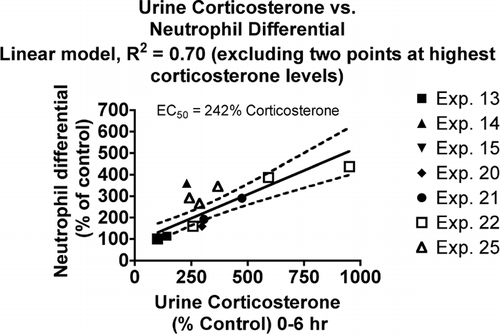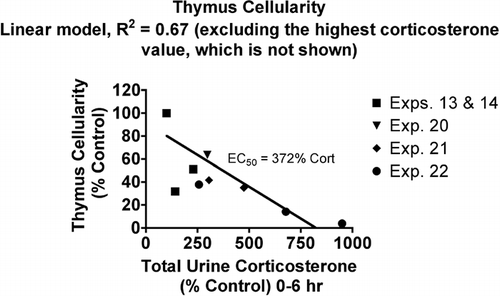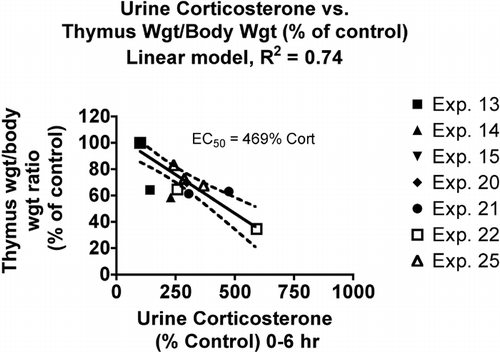Figures & data
FIG. 1 Relationship between urine corticosterone and neutrophil differential count in the blood. Values for both parameters were normalized by expressing control values as 100% and comparing the values for treated animals to this value. Each symbol represents the mean values for one group of rats (4–7 rats per group, see Materials and Methods). Symbols of the same type indicate groups from a particular experiment. The linear model was derived and r-squared values calculated using Prism 4.0 software (GraphPad, San Diego).

FIG. 2 Relationship between urine corticosterone and lymphocyte differential count in the blood. Values for both parameters were normalized by expressing control values as 100% and comparing the values for treated animals to this value. Each symbol represents the mean values for one group of rats (4–7 rats per group, see Materials and Methods). Symbols of the same type indicate groups from a particular experiment. The linear model was derived and r-squared values calculated using Prism 4.0 software.

FIG. 3 Relationship between urine corticosterone and thymus cellularity. Values for both parameters were normalized by expressing control values as 100% and comparing the values for treated animals to this value. Each symbol represents the mean values for one group of rats (4–7 rats per group, see Materials and Methods). Symbols of the same type indicate groups from a particular experiment. The linear model was derived and r-squared values calculated using Prism 4.0 software.

FIG. 4 Relationship between urine corticosterone and thymus weight to body weight ratio. Values for both parameters were normalized by expressing control values as 100% and comparing the values for treated animals to this value. Each symbol represents the mean values for one group of rats (4–7 rats per group, see Materials and Methods). Symbols of the same type indicate groups from a particular experiment. The linear model was derived and r-squared values calculated using Prism 4.0 software.

FIG. 5 Relationship between urine corticosterone and neutrophil differential count in the blood. Values for both parameters were normalized by expressing control values as 100% and comparing the values for treated animals to this value. Each symbol represents the mean values for one group of rats (4–7 rats per group, see Materials and Methods). Symbols of the same type indicate groups from a particular experiment. The linear model was derived and r-squared values calculated using Prism 4.0 software.
